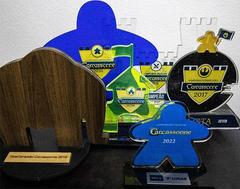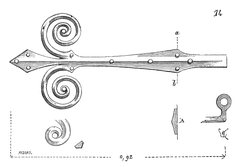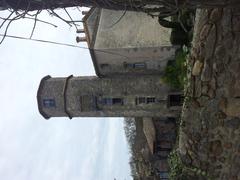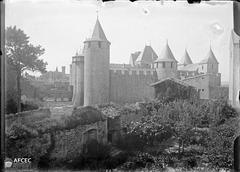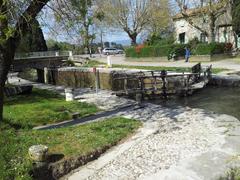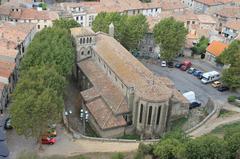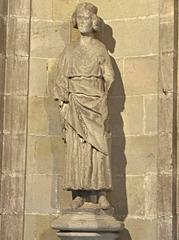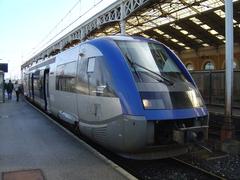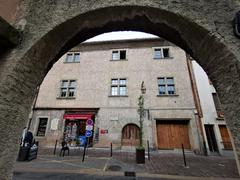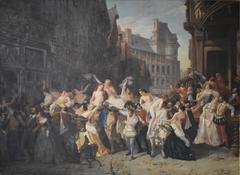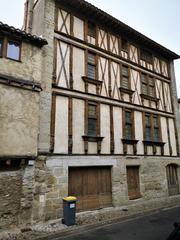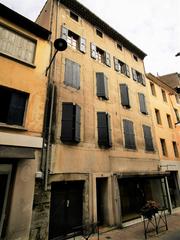Temple De Carcassonne: Visiting Hours, Tickets, and Historical Guide to Carcassonne’s Medieval Sites
Date: 04/07/2025
Introduction
Nestled in the heart of southern France, the Cité de Carcassonne is widely celebrated as one of Europe’s most impressive medieval fortified cities. Its imposing double ramparts, crowned by more than 50 towers and interwoven with cobbled streets, create an unrivaled setting for historical discovery. This UNESCO World Heritage Site is not only a marvel of medieval military architecture, but also a vibrant city where history, culture, and local life converge.
Tracing its origins from ancient Celtic settlements through Roman, Visigothic, and Frankish periods, Carcassonne’s layered past is palpable in every stone. The city’s centerpiece, the Château Comtal, alongside the Basilica of Saints Nazarius and Celsus, speaks to a legacy of resilience, faith, and artistry. Today, Carcassonne continues to thrive as both a living monument and a hub for cultural events, attracting millions of visitors annually.
This comprehensive guide will provide detailed insights into Carcassonne’s history, practical information for visitors—including opening hours, ticketing, accessibility, and local tips—and highlight the must-see attractions within the citadel. Whether you are a history enthusiast or a curious traveler, this resource will help you plan an enriching and seamless visit.
For deeper historical background and up-to-date visitor information, see remparts-carcassonne.fr, Interesting Engineering, and France Travel Guide.
Table of Contents
- Introduction
- Early Origins and Roman Foundations
- Visigothic and Medieval Periods
- The Trencavel Dynasty and Château Comtal
- The Albigensian Crusade and Royal Fortification
- Decline, Restoration, and UNESCO Status
- The Temple De Carcassonne: Myths and Historical Context
- Architectural and Cultural Significance
- Practical Visitor Information
- Key Attractions Within the Citadel
- Seasonal Events and Local Culture
- Nearby Attractions and Transportation
- Visitor Tips and FAQs
- Conclusion and Recommendations
- Sources and Further Reading
Early Origins and Roman Foundations
Carcassonne’s story begins at least as early as 800 BCE, with Celtic settlements on the strategic hilltop above the River Aude (remparts-carcassonne.fr). The Romans recognized the site’s military value, incorporating Carcaso into their empire in the 1st century BCE. By the 3rd and 4th centuries CE, they had constructed formidable stone walls, the remnants of which still form part of the inner ramparts (historytools.org).
Visigothic and Medieval Periods
After Rome’s decline, the Visigoths seized Carcassonne in the 5th century CE, enhancing the city’s defenses and establishing it as a regional power center. The Basilica of Saints Nazarius and Celsus, built during this era, signaled Carcassonne’s rising religious significance (explorecity.life). The city changed hands during the 8th century, briefly falling under Muslim rule before being reclaimed by the Franks, who further fortified it as a Carolingian bastion.
The Trencavel Dynasty and Château Comtal
The 11th and 12th centuries were transformative for Carcassonne. In 1067, the Trencavel family acquired the city, launching construction of the Château Comtal—a palatial stronghold that became Carcassonne’s administrative and military heart (lifeinruralfrance.com). Under Trencavel stewardship, Carcassonne flourished as a commercial and cultural hub along major Mediterranean-Atlantic trade routes (hollymelody.com).
The Albigensian Crusade and Royal Fortification
In the early 13th century, Carcassonne became embroiled in the Albigensian Crusade, a papal initiative to eradicate Cathar heresy. As a Cathar stronghold, Carcassonne endured a notorious siege in 1209, after which it was annexed by the French crown (medievalhistoria.com). King Louis IX and successors reinforced the fortress with a second outer wall and an array of towers, making it one of the most impregnable cities in Europe (billets-carcassonne.fr).
Decline, Restoration, and UNESCO Status
Carcassonne’s strategic importance waned after the Treaty of the Pyrenees in 1659. The citadel fell into neglect until the 19th-century, when threatened demolition sparked a national preservation campaign. Architect Eugène Viollet-le-Duc’s restoration efforts from 1849 onward revived the city’s medieval grandeur, albeit with some romanticized elements (en.wikipedia.org). In 1997, the Cité de Carcassonne was recognized as a UNESCO World Heritage Site for its exceptional preservation and historical value (remparts-carcassonne.fr).
The Temple De Carcassonne: Myths and Historical Context
There is no specific structure known as the “Temple De Carcassonne.” The term, used colloquially, often refers to the city’s religious and military heritage—especially the Basilica of Saint-Nazaire and the Château Comtal. While the Knights Templar owned nearby properties, they had limited direct presence within Carcassonne itself (thetemplarknight.com). Nonetheless, Templar and Cathar legends continue to enrich guided tours and local lore.
Architectural and Cultural Significance
Fortifications and Layout
Carcassonne’s architecture is distinguished by its double ring of ramparts, extending 3 kilometers and featuring 52–53 towers (France Travel Tips). Key elements include:
- Porte Narbonnaise: The primary entrance, flanked by two massive towers (Interesting Engineering).
- Barbicans and Moats: Defensive outworks like the Saint-Louis Barbican and grassy moats.
- Château Comtal: The central castle, with drawbridge and independent walls.
- Basilica of Saints Nazarius and Celsus: An exquisite blend of Romanesque and Gothic design, featuring some of southern France’s oldest stained glass (midi-france.info).
Restoration and Preservation
The 19th-century restorations by Viollet-le-Duc and his successors set new standards for heritage preservation, ensuring Carcassonne remains among Europe’s most complete medieval fortresses (EAA).
Cultural Impact
Carcassonne’s silhouette has inspired artists, architects, and filmmakers worldwide—its story and appearance serving as models for everything from fairy tale castles to cinematic backdrops (Interesting Engineering).
Practical Visitor Information
Visiting Hours
- Citadel Grounds: Open daily, typically 9:00 AM–7:00 PM in summer, 10:00 AM–5:00 PM in winter. Hours may vary; check the official site for updates.
- Château Comtal: Separate opening times, often closing earlier than the citadel gates.
Ticketing
- Citadel Entry: Free
- Château Comtal and Ramparts: Paid entry; tickets approx. €10–13 for adults, with discounts for children, students, and seniors. Children under 18 often free (remparts-carcassonne.fr).
- Advance Booking: Highly recommended, especially in high season, via the official website.
Accessibility
- The main streets and several attractions are accessible, though uneven cobblestones and stairs limit access to some ramparts and towers. Wheelchair users should consult the latest accessibility details before visiting.
Guided and Self-Guided Tours
- Multiple guided tours are offered in various languages; audio guides and map-based self-guided options are available for independent exploration.
Key Attractions Within the Citadel
Château Comtal
The restored castle showcases medieval life, architecture, and exhibitions, with rampart walks offering panoramic city views (Off the Tourist Treadmill).
Basilica of Saints Nazarius and Celsus
Features some of France’s oldest stained glass and a harmonious blend of architectural styles (The Crazy Tourist).
The Clock Tower (La Horloge)
A climb to the top provides sweeping views and insight into the citadel’s structure (The Tourist Checklist).
Porte Narbonnaise
The main gateway, offering a dramatic entrance and a sense of the site’s defensive ingenuity.
Seasonal Events and Local Culture
- Festival de Carcassonne (July): Over 120 music, dance, opera, and theater performances, many free (grand-carcassonne-tourisme.co.uk).
- Bastille Day Fireworks (July 14): A celebrated spectacle with the fortress illuminated against the night sky.
- Medieval Markets and Reenactments: Regular events immerse visitors in local traditions.
- Cuisine: Sample cassoulet and Languedoc wines in local restaurants and cafés (Generation Voyage).
Nearby Attractions and Transportation
- Canal du Midi: UNESCO-listed waterway ideal for walks, cycling, or boat trips.
- Lac de la Cavayère: A recreational lake for swimming and picnics (occitanietravel.com).
- Other Castles: Explore the “Five Sons of Carcassonne”—Aguilar, Peyrepertuse, Puilaurens, Quéribus, and Termes (occitanietravel.com).
Getting There:
- By Train: Direct links from Toulouse, Narbonne, and Bordeaux; 30-minute walk from station to citadel (planatriptofrance.com).
- By Car: Paid parking near entrances; short uphill walk to main gates.
- By Bus & Local Transport: Regional buses and seasonal tourist trains connect key sights within the city.
Visitor Tips and FAQs
- Footwear: Wear sturdy shoes for cobblestones and ramparts.
- Photography: Sunrise and sunset provide the best light for photos; tripods allowed outdoors.
- Weather: Summers can be hot and crowded; spring and fall offer milder weather and fewer visitors.
- Facilities: Restrooms, shops, and dining are available within the citadel.
- Online Booking: Strongly encouraged for tickets, especially in peak months.
FAQs
Q: What are Carcassonne’s visiting hours?
A: The citadel is open daily, usually 9:00 AM–7:00 PM in summer, with shorter winter hours. Château Comtal may close earlier.
Q: How much do tickets cost?
A: Entry to the citadel is free; Château Comtal and ramparts require a ticket (approx. €10–13 for adults, discounts available).
Q: Are guided tours available?
A: Yes, in multiple languages, plus audio guides for self-paced visits.
Q: Is the site accessible?
A: Partial accessibility; some historic areas and ramparts are challenging for those with mobility issues.
Q: When is the best time to visit?
A: Spring and early autumn for pleasant weather and smaller crowds.
Conclusion and Recommendations
The Cité de Carcassonne offers an immersive journey through centuries of history, art, and local tradition. Meticulously preserved and brimming with cultural life, it is a must-visit for anyone interested in Europe’s medieval heritage. Careful planning—considering opening hours, ticketing, and accessibility—will ensure a rewarding experience.
For the latest updates, special events, and personalized guides, download the Audiala app. Explore more of our articles on French historical sites, and follow us on social media for insider tips and inspiration.
Sources and Further Reading
- remparts-carcassonne.fr
- Interesting Engineering
- offthetouristtreadmill.com
- remparts-carcassonne.fr - Practical Information
- France Travel Guide
- Grand Carcassonne Tourism
- historytools.org
- explorecity.life
- lifeinruralfrance.com
- hollymelody.com
- medievalhistoria.com
- billets-carcassonne.fr
- midi-france.info
- thetemplarknight.com
- History Skills
- EAA
- France Travel Tips
- Generation Voyage
- The Girl Who Goes
- Off the Tourist Treadmill
- The Crazy Tourist
- The Tourist Checklist
- France Adventurer
- Wanderlog
- France Voyage
- planatriptofrance.com
- grand-carcassonne-tourisme.co.uk
- occitanietravel.com
- cityzeum.com
- armchairtraveler2022.wordpress.com
- nomads-travel-guide.com
- touristplaces.guide
